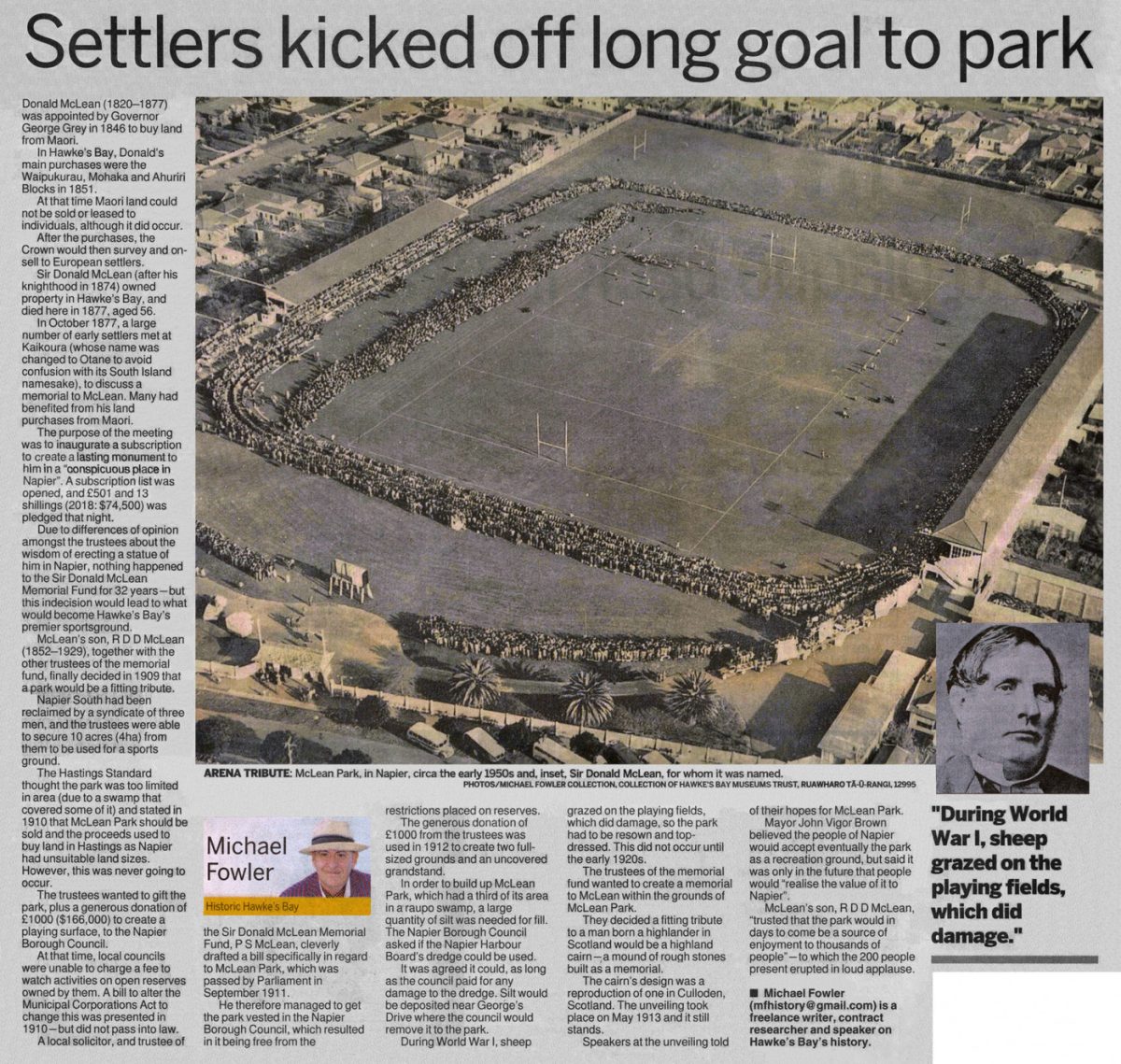Settlers kicked off long goal to park
Donald McLean (1820-1877) was appointed by Governor George Grey in 1846 to buy land from Maori.
In Hawke’s Bay, Donald’s main purchases were the Waipukurau, Mohaka and Ahuriri Blocks in 1851.
At that time Maori land could not be sold or leased to individuals, although it did occur.
After the purchases, the Crown would then survey and on-sell to European settlers.
Sir Donald McLean (after his knighthood in 1874) owned property in Hawke’s Bay, and died here in 1877, aged 56.
In October 1877, a large number of early settlers met at Kaikoura (whose name was changed to Otane to avoid confusion with its South Island namesake), to discuss a memorial to McLean. Many had benefited from his land purchases from Maori.
The purpose of the meeting was to inaugurate a subscription, to create a lasting monument to him in a “conspicuous place in Napier”. A subscription list was opened, and £501 and 13 shillings (2018: $74,500) was pledged that night.
Due to differences of opinion amongst the trustees about the wisdom of erecting a statue of him in Napier, nothing happened to the Sir Donald McLean Memorial Fund for 32 years – but this indecision would lead to what would become Hawke’s Bay’s premier sportsground.
McLean’s son, R D D McLean (1852 – 1929), together with the other trustees of the memorial fund, finally decided in 1909 that a park would be a fitting tribute.
Napier South had been reclaimed by a syndicate of three men, and the trustees were able to secure 10 acres (4ha) from them to be used for a sports ground.
The Hastings Standard thought the park was too limited in area (due to a swamp that covered some of it) and stated in 1910 that McLean Park should be sold and the proceeds used to buy land in Hastings as Napier had unsuitable land sizes. However, this was never going to occur.
The trustees wanted to gift the park, plus a generous donation of £1000 ($166,000) to create a playing surface, to the Napier Borough Council.
At that time, local councils were unable to charge a fee to watch activities on open reserves owned by them. A bill to alter the Municipal Corporations Act to change this was presented in 1910 – but did not pass into law.
A local solicitor, and trustee of the Sir Donald McLean Memorial Fund, P S McLean, cleverly drafted a bill specifically in regard to McLean Park, which was passed by Parliament in September 1911.
He therefore managed to get the park vested in the Napier Borough Council, which resulted in it being free from the restrictions placed on reserves.
The generous donation of £1000 from the trustees was used in 1912 to create two full-sized grounds and an uncovered grandstand.
In order to build up McLean Park, which had a third of its area in a raupo swamp, a large quantity of silt was needed for fill. The Napier Borough Council asked if the Napier Harbour Board’s dredge could be used.
It was agreed it could, as long as the council paid for any damage to the dredge. Silt would be deposited near George’s Drive where the council would remove it to the park.
During World War 1, sheep grazed on the playing fields, which did damage, so the park had to be resown and top-dressed. This did not occur until the early 1920s.
The trustees of the memorial fund wanted to create a memorial to McLean within the grounds of McLean Park.
They decided a fitting tribute to a man born a highlander in Scotland would be a highland cairn – a mound of rough stones built as a memorial.
The cairn’s design was a reproduction of one in Culloden, Scotland. The unveiling took place on May 1913 and it still stands.
Speakers at the unveiling told of their hopes for McLean Park.
Mayor John Vigor Brown believed the people of Napier would accept eventually the park as a recreation ground, but said it was only in the future that people would “realise the value of it to Napier”.
McLean’s son, R D D McLean, “trusted that the park would in days to come be a source of enjoyment to thousands of people” – to which the 200 people present erupted in loud applause.
“During World War l, sheep grazed on the playing fields which did damage.”
Michael Fowler ([email protected]) is a freelance writer, contract researcher and speaker on Hawke’s Bay’s history.
Photo caption – ARENA TRIBUTE: McLean Park, in Napier, circa the early 1950s and, inset, Sir Donald McLean, for whom it was named.
PHOTOS/MICHAEL FOWLER COLLECTION,COLLECTION OF HAWKE’S BAY MUSEUM TRUST, RUAWHARO TĀ-O-RANGI [TA-U-RANGI], 12995












Do you know something about this record?
Please note we cannot verify the accuracy of any information posted by the community.